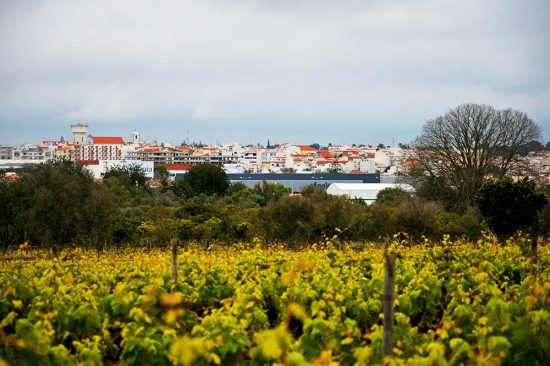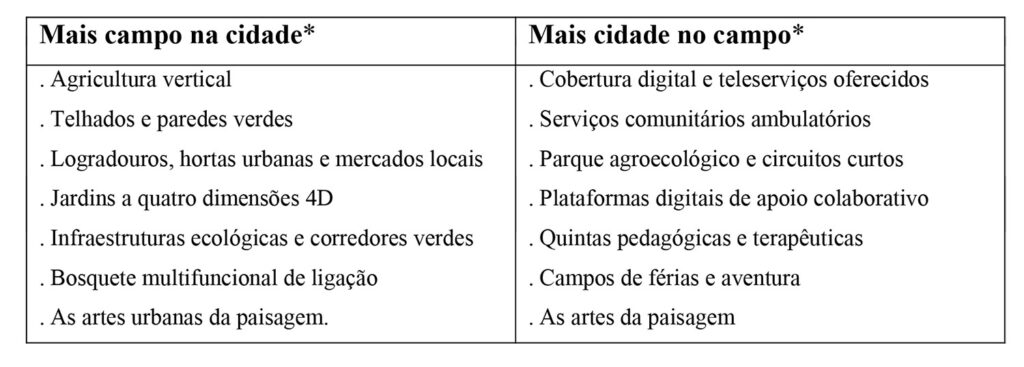"... the green structure should not be conceived a posteriori, materialized in a mere vegetal decoration, in landscaping arrangements, in the vegetalization and framing of infrastructures or in pictorial landscaping, but conceived as a work of landscape architecture that is supported by an interdisciplinary participation» (Gonçalo Ribeiro Telles, 2003: 331)
Now that there is so much talk about the candidatures for the European capital of culture 2027, it is worth mentioning that one of its core elements concerns the quality of its green infrastructures, where nature and culture exchange many of their best arguments.
In the urban agroecology of the city of the future, green infrastructure will have a prominent place in urban planning, prevention and therapeutics. These ecological infrastructures or, if we like, biophysical operators of the city, will be essential in its territorial projection, in particular the new city-countryside connections, as they can function as the turning plates of green corridors and networks of green corridors or as new places of the city of the future and, therefore, like so many other places of interface with culture.
The landscape and green infrastructure
We know that the landscape has a pattern determined by the relief, the ecosystems and the type of soil and that it forms a mosaic composed of three elements, the main patch, the fragments and the corridors. Obviously, the spatial configurations between patches, patches and corridors are of great ecological importance and determine the movements of people and animals as well as water lines across the landscape.
We also know that the main patch is very variable, more or less homogeneous and linear, and that the shape of the elements has different degrees of connectivity, while the corridors are systems-conductors for the circulation of species and, depending on the size and variety of species, may constitute habitats or circulation or dispersion corridors.
Obviously, the circulation of species and populations between the different fragments of a landscape mosaic increases with scale, while connectivity is reinforced and natural functions essential for sustainability are performed.
We also know that fragmentation occurs both by natural causes and by human action, through large equipment and infrastructure. The size of the fragments and the nature and degree of connectivity of the elements determine the configuration of the landscape and this the configuration of the corridors.
Although we know that the effectiveness of corridors can only be proven over many years or decades, we also know that it is not possible to wait for the results as the landscapes will already be irreparably altered in terms of structure and function.
Planning, permanent monitoring and adaptive management are the best solution available.
We also know that watercourses, with their riparian galleries and respective hydrological dynamics, are a green corridor par excellence. However, with urban development, there has been an extensive waterproofing of the soil, through paving or compaction, and a suppression of the forests that guaranteed the permeability and humidity of the soil, fundamental for its maintenance in good ecological conditions.
The obvious consequence is that water flows more easily and carries waste into water bodies, generating silting and pollution and changing the hydrological dynamics of the waterline, which, in turn, disturb the ecology of aquatic ecosystems and affect the respective fauna and flora.
The same can be said of urban forests that can be designed to contain landslides, prevent soil erosion, maintain the quality of water, air and the environment, as well as the quality of life of citizens in general. .
Finally, we know that the more intensive, compact and dense the city and its urbanization are, the more it is projected into its area of influence, for the best and worst reasons: changes in land use and occupation, the segregation of income, more water, air and soil pollution, greater distances to be covered, greater dependence on the car, greater energy consumption, more sedentary lifestyle and more aggressive pathologies, less natural areas and less access to open spaces and, finally, less sociability associated with greater urban danger and risk.
Green infrastructure and new city-country connections
I insist on my argument, green infrastructures are a fundamental element of the city-countryside connection and, therefore, a cultural element par excellence. In green corridors and networks of green corridors, we must not only take the opportunity to reprogram city-countryside relations, but also to change our habits and behaviors towards nature, since nature is a mediator of social relations.
If we are aggressive with nature, the environmental impacts of our action will have strong social implications and, in turn, this social disturbance will have repercussions again on the ecosystem and the living conditions it provides.
Green infrastructures can make densely populated areas pleasant and sought after and improve coexistence between citizens. The ecological integrity and the health of the respective flora and fauna contribute to the same objective. A place with a strong integrity of its landscape will, in principle, have a good representation of itself, it is a place that will end up valuing social, economic, recreational and aesthetic functions.
This will be the case if, through biophysical planning, we know how to take advantage of the topography and morphology of space and adapt the city project to the local community.
Finally, green infrastructures can become a true laboratory for experimenting with the uses of the territory, taking care of its main constituent structures, as long as it has not been designed to solve mere emergency or circumstantial problems.
In the particular case of multifunctional agroecology, green infrastructures can materialize all its main functions: reconciling multiple uses for humans in direct contact with nature, rescuing biodiversity and ecosystems, rescuing densely populated areas, testing environmental education methodologies and , also, the methodologies of permanent monitoring.
In the urban agroecology of the city of the future, green infrastructures will be essential in the territorial projection of the city, as they can function as the turntables of green corridors and networks of green corridors or as new central places of the city-region.
Let us recall, as an example, the main ones:
– Integrated micro energy generation systems or networks;
– The integrated management of the various sources of freshwater,
– Sustainable construction and climate bio-regulation;
– The multifunctional forest, the urban forest and carbon capture;
– Urban and peri-urban agriculture for food supply;
– The promotion of ecosystem services among the population;
– The promotion of green corridors connecting the most sensitive areas;
– Bio purification lakes;
– Urban composting and experimentation in urban vertical agriculture;
– The construction of agroecological, recreational and therapeutic amenities.
The table I present is a simplified example of this new city-country connection:
*More countryside in the city and More city in the countryside: According to the concepts of global landscape and continuum natural environment, all these elements must function as ecological infrastructures and green corridors, according to an integrated design of landscape architecture and biophysical engineering.
In the midst of the technological and digital age, however, there is a fundamental doubt, namely: it is very likely that speed will substantially reduce the city-country distance, but at the same time contribute to a paradoxical look at the most remote territories of the interior. , to the exact extent that nomadism and mobility prevent the formation of a critical urbanism that allows them to counteract the movements towards the coast.
In the end, after architecture and civil engineering, we chose landscape architecture and biophysical engineering to restore many of the social and ecological balances that had been broken before, choosing these green infrastructures as many other biophysical operators in the design of new city-countryside connections. and in the creation of new multifunctionalities that appear necessary for the proper functioning of the networks for the use of the territory.
Final Notes
As we said, green infrastructure, in general, can be a real laboratory for experimenting with the uses of the territory, taking care of its main constituent structures, as long as they have not been designed to solve mere emergency or circumstantial problems, as unfortunately happens. So many times.
This is also the reason why public consultation and participation processes are fundamental in the design of these infrastructures and their main functions: reconciling the multiple uses of land, rescuing biodiversity and ecosystems, rescuing densely populated areas, testing methodologies for environmental education and also the methodologies of permanent monitoring.
In the end, as the architect Gonçalo Ribeiro-Telles says, it is a matter of moving from verdismo and landscaping to biophysical planning, that is, to the circular metabolism of elements, their ecological restoration and rehabilitation, of respecting the rationale of the global landscape and the vertebral function of the municipal ecological structure, as well as the energetic complementarity and the integrated systems of micro generation which include bio construction, bio climatization and local agri-food systems of proximity, in short, to promote the forms of local governance and dedicated institutionality and a new culture of fusion between the city and the countryside.
Author António Covas is a Retired Full Professor at the University of Algarve





















Comments